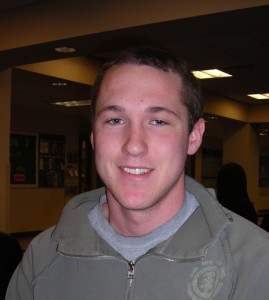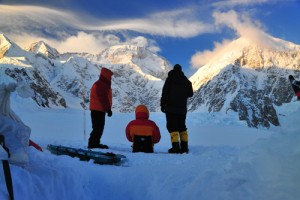
While his classmates were cramming for finals in the spring of 2008, senior Cameron Carson was enduring the toughest physical test of his life so far – climbing North America’s highest mountain.
On Mount McKinley, Carson and his fellow climbers battled subzero temperatures, 150 mph winds and low oxygen levels throughout the grueling climb, but he said the experience was worth it.
“One thing I learned about mountain climbing is you have to be willing to suffer to reach your goal,” Carson said. “Mountain climbing is a different type of workout. It’s a challenge, but you get a much greater sense of success rather than pumping a bar in a gym.”
The high winds kept Carson and his group from reaching the summit of Mount McKinley because they would have run out of food if they had waited until the winds died down. However, Carson climbed to an altitude of 16,000 feet, just 4,320 feet short of the mountain’s summit, and he wants to return someday.
“I’d like to go back and try to summit, if my girlfriend will let me,” Carson said. “She doesn’t like me to go because of the danger. My parents wonder where [my love of mountain climbing] comes from, and they worry sometimes.”
Carson’s girlfriend, junior Danielle Bores, said she knows Carson is a good climber but still worries because mountain climbing can be a dangerous hobby.
“I think, ‘He could get caught in an avalanche, get injured or fall off a cliff and die,'” Bores said.
Start of a hobby, future plans
When Carson was young, his parents would occasionally take him to Vertical Endeavors, an indoor rock climbing facility. But he didn’t start to seriously climb until his freshman year at St. Thomas, when he started rock climbing four to five times a week. He also founded the Rock Climbing Club at St. Thomas, which provides students with opportunities to go on weekly rock climbing excursions.
Junior Hans Pflaumer, who took over as club president this year because Carson is preparing to graduate, said he would describe Carson as “conscientiously fearless.”
“He’s fearless with things he can control, but he knows his limits and he knows how far to push himself,” Pflaumer said.
Since freshman year, Carson has gone on a climbing trip to the Badlands in South Dakota and has climbed mountains in California’s Kings Canyon National Park. Since his trip to Mount McKinley, he has started to plan another mountain climbing expedition to Mount Kilimanjaro, the highest peak in Africa.
“I’d really like to [climb] it, hopefully between this summer and next summer,” Carson said. “I’m waiting to be done with school, and I have to figure out the budget and who can go.”
Carson would someday like to “do the seven summits.”
“That’s when you climb to the tallest point on each continent,” Carson said. “It’s an awesome goal.”
Climbing Mount McKinley
Since Carson has climbed Mount McKinley, the highest peak in North America, he can already check one of the seven off his list. He said the experience of climbing Mount McKinley was like nothing he had ever done before.
“My favorite part was spending weeks sleeping above the clouds,” Carson said.
But the climb also had elements of danger.
“While we were on the mountain, two Japanese climbers went missing and were never found,” Carson said. “A Spanish woman lost eight fingers due to frostbite, and a German climber lost four or five toes.”

Carson had to be in peak physical condition to climb so his body wouldn’t be susceptible to the many health risks of living for weeks in thinner, colder air.
“You face things like HAPE and HAZE, where your lungs or brain cavities fill with liquid,” Carson said. “You have to have the physical power to do something about it.”
Carson trained for weeks before the climb, doing aerobic exercises and lifting weights to prepare his body for the harsh demands of mountain climbing.
“We climbed McKinley expedition style, which means you carry more gear,” he said. “We wore 80 to 90 pound packs and pulled sleds with 40 or 50 pounds behind us.”
The trip was sponsored by an organization called Climbing for Christ. Climbers going on trips through the organization typically evangelize and bring food and water to people living in impoverished mountain communities. However, Carson described the excursion as a “bridging trip.”
“Many people don’t see Christians in a mountain climbing environment,” he said. “We helped them realize Christians can be normal people, not just Bible pushers.”
Adventures during the climb
Carson said one challenging day during the climb was when they started going down the mountain and winds were blowing over 100 mph.
“The weather reports said the winds were supposed to die down, but they stayed about the same,” Carson said. “The wind blew off the loose snow, so it was just glacial ice. We got to a big open field which ended in a cliff with a 6,000 foot drop-off, and there was only a narrow path as wide as your feet.”
The climbers were roped together for safety, which made it more difficult to go through the passageway.
“One person froze up and didn’t want to go anywhere,” Carson said. “We needed him to go because we were all connected to him, so we had to help him get over his fears.”
Carson’s group climbed alongside groups from around the world, and he said he enjoyed meeting people from different countries.
“We had an ‘International Sexy Contest’ for fun, and two Austrian brothers won,” Carson said.
He said one of the most memorable parts of the trip was watching a blind man climb Mount McKinley.
“He was in the middle of the rope, and the other guys would tell him where and how to move. It was amazing,” Carson said. “There’s lots of teamwork involved in mountain climbing.”
Katie Broadwell can be reached at klbroadwell@stthomas.edu.
